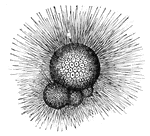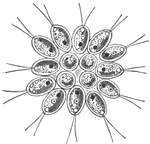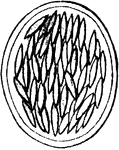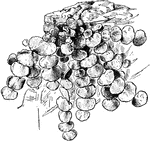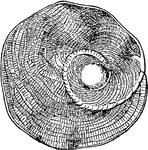The Algae ClipArt gallery offers 120 images of these eukaryotic organisms that lack many organs found in land plants. The most known and largest examples are seaweeds.
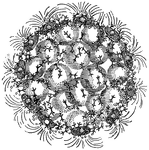
Sphaerozoum Ovodimare
"A genus compound radiolarians, typical of the family Sphaerozoidae, the protoplasm of which contains…
Acinetæ
"An order of the class Infusoria, the adult members of which have no cilia and no proper mouth, and…

Alga
Magnified view of some of a simple fresh water Alga, the Tetraspora lubrica, each sphere of which may…
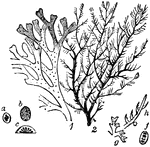
Algae
"A division of thallogenous chlorophyllous cryptograms found in the most part in the sea or in freshwater."-Whitney,…

Protococcus Algae
"a genus of algae. P.nivalis (red-snow) appears on the surface of snow, tinging extensive tracts in…

Amebas
An animal that lives in stagnant water. It is so small that it can only be seen with a microscope.

Brown Alga
"Fucus platycarpus...3. jointed branching hairs detached from the sides of the conceptacle and bearing…
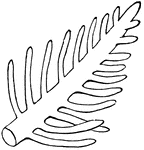
Bryopsis Plumosa
Bryopsis plumosa; apex of a stem with its branchlets; all the extension of one cell.

Chara
They grow in pools and slow streams rooting in the ground and growing erect. Some species when taken…
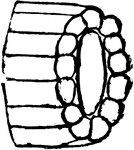
Chara
Outlines of a portion of the stem in section, showing the central cell and the outer or cortical cells.
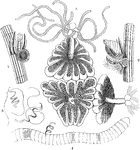
Chara fragilis
"1. Antherid and spore-case of Chara fragilis not much magnified; 2. the same at a later period, after…

Chara Vulgaris
Chara vulgaris, a modern lime-secreting alga, growing in fresh water. An important marl and limestone…

Chara Vulgaris
Chara vulgaris, a recent calcareous alga (fresh water); sport-vessel with corona. This is frequently…
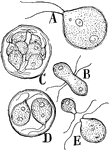
Chlamydomonas
This illustration shows the features in the life history of Chlamydomonas: A, character of the motile…

Spirogyra Chloroplast
"B, cell of Spirogyra, with spiral chloroplast at c, nucleus at n, and pyrenoid at e." -Stevens, 1916

Spirogyra Chloroplast
"C, cross section of Spirogyra cell, with nucleus at n, and section of chloroplast and pyrenoid below."…
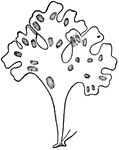
Chondrus Crispus
Small plant of Chondrus crispus, Carrageen Moss; the spots represent the fructification, consisting…

Coccolithophora
A mass of coccoliths; a marine pelagic plant of low order covered with calcereous plates. A coccolithophore…
Conferva
The growing end of a branching Conferva (Cladophora glomerata), showing how, by a kind of budding growth,…
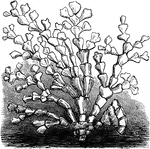
Coralline
Coralline Rock is a type of rock formed by the death of layers of Coralline algae. It is visually quite…

Delesseria Lepreiurei
A piece of the rose-red Delesseria Lepreiurei, showing that it is composed of a layer of cells.
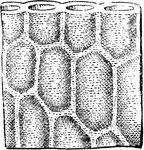
Delesseria Lepreiurei
A piece of the rose-red Delesseria Lepreiurei, showing the cells are gelatinous and thick-walled.
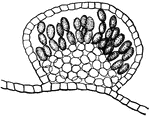
Delesseria Lepriuerei
Section through a conceptacle of Delesseria Leprieurei, showing the spores, which are single specialized…
Desmid
Closterium acutum, a common Desmid. It is a single firm-walled cell, filled with green protoplasmic…
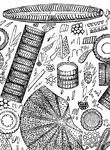
Diatom
A major group of eukaryotic algae, one of the most common type of phytoplankton. Most diatoms are unicelular,…
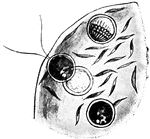
Eudorina
These protozoans form colonies. Formation of the two kinds of reproductive cells of Eudorina.

Eudorina
"Eudorina. The development of reproductive bodies within the colony from the ordinary vegetative cells…
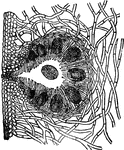
Fertile Conceptacle of Rockweed
Magnified section through a fertile conceptacle of Rockweed, showing the large spores in the midst of…
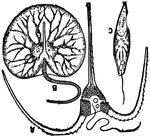
Flagellata
Flagellata is an order of Protozoa characterized by the presence of flagellae (whip-like structures…

Foraminifera
Foraminifera are minute shelled animalcules. They secrete a hard covering or shell made of sand or carbonate…
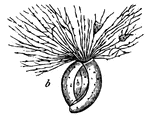
Foraminifera
Foraminifera are minute shelled animalcules. They secrete a hard covering or shell made of sand or carbonate…
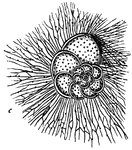
Foraminifera
Foraminifera are minute shelled animalcules. They secrete a hard covering or shell made of sand or carbonate…

Foraminifera
Foraminifera are minute shelled animalcules. They secrete a hard covering or shell made of sand or carbonate…
Foraminifera
Foraminifera are minute shelled animalcules. They secrete a hard covering or shell made of sand or carbonate…

Foraminifera
The Foraminifera, ("Hole Bearers") or forams for short, are a large group of amoeboid protists…

Fucus Vesiculosus
"Fucus vesiculosus: showing the receptacles of the fructification a, a, at the ends of the branching…
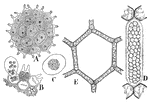
Green Algae
This illustration shows the colonial forms of unicellular green algae: A, Pediastrum, the plants of…
Gregarina
Gregarina is a parasitic protozoan. They live in the alimentary canal of crayfish, and certain insects.
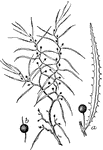
Gulfweed Branch
"Branch of Gulfweed (Sargassum bacciferum). a, vesicle with leaf; b, mucronate vesicle." -Whitney, 1911










